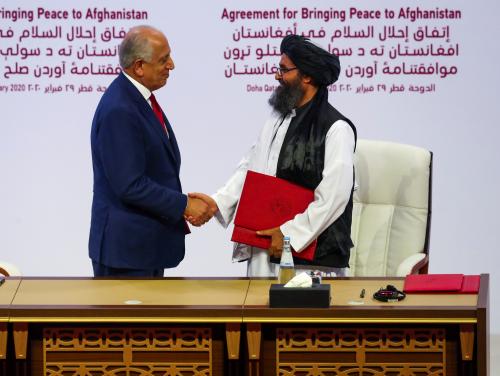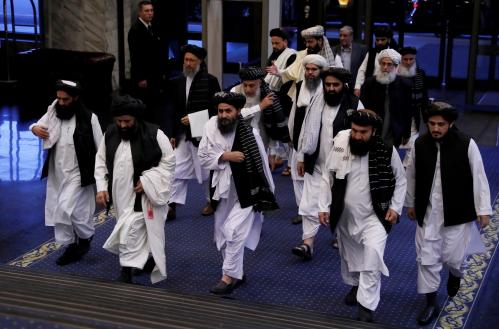Senior Fellow Vanda Felbab-Brown breaks down how high-value targeting, when used in practice, is not the sole element of the counterinsurgency success and presents various problematic side-effects. This piece was originally published by Mexico Today.
Apart from human rights and civil liberties concerns, the recent decisions of the Mexican Congress to place the National Guard under the control of the Mexican military and to extend the role of the Mexican military in domestic policing until 2028 also fundamentally fail to address the design and content of policing in Mexico. Both the Mexican military and the National Guard have been troubled with tools of policing, and during the Andrés Manuel López Obrador administration, tools without a strategy. The fact that neither the military nor the guard has investigative authorities and capacities, and can act only against in flagrante crimes, severely limits how effective at policing either could become. López Obrador’s directive that both agencies avoid using force severely worsens law enforcement deficiencies and compounds the brazen sense of impunity of Mexican criminal groups.
The absence of a law enforcement strategy in Mexico today stems from a rejection of high-value targeting that during the Felipe Calderón and Enrique Peña Nieto administrations dominated policing approaches and fragmented criminal groups. Without the groups being dismantled and the state having the capacity to field effective police forces, the fragmentation became a key driver of violence.
So what is the global record of the effects of high-value targeting, so frequently practiced in law enforcement, counterinsurgency, and counterterrorism operations?
High-value targeting has been applied in the wars in Iraq, Afghanistan, Somalia, Yemen, Syria, Peru, Colombia, Nigeria and beyond as well as against criminal groups, such as in Colombia and Mexico. It is built around the notion that decapitating the leaders of terrorist, insurgent, militia, and criminal groups will defang the group’s operational capacity and make the group easier to defeat.
There are basic moral reasons to bring to accountability leaders of heinous terrorist and criminal groups – be they Abu Bakr al-Baghdadi, the killed leader of the Islamic State in Iraq and the Levant, or Joaquín “El Chapo” Guzmán, the head of the Sinaloa Cartel. If they cannot be brought to a trial, like “El Chapo” was in the United States in 2019, killing them can serve justice – such as the killings al Qaeda’s leaders Osama bin Laden or Ayman al-Zawahiri did.
Such kills may also sometimes succeed as deterrent shots across the bow of a nonstate armed actor whose behavior a government seeks to shape and deter from the most dangerous acts.
Yet the other promises of high-value targeting, such as sapping the potency of the armed nonstate actors, have rarely panned out. One unique success case was the arrest of Abimael Guzmán, the leader of the Shining Path in Peru. The capture of Guzmán and most of the Shining Path leadership came after years of a painstaking intelligence operation led by a small select Peruvian police cell assisted by the United States. The decapitation success was the final nail in the Shining Path’s coffin. It resulted in most of the rank-and-file members and middle-level leaders also surrendering after the captured Guzmán called on his followers to give up so he would not receive the death penalty. Still, some factions persisted in the armed struggle and drug trafficking.
But even in the Guzmán case, the extensive leadership decapitation was not the sole element of the counterinsurgency success and was far from sufficient for defeating the almost victorious leftist guerrillas. Well before the leadership capture, the Shining Path was defeated in Peru’s rural areas as a result of the suspension of coca eradication and interdiction. Halting counternarcotics operations flipped local communities and drug traffickers to the side of the government, spurred the creation of rural militias, and produced extensive intelligence flows from the drug traffickers to the government.
But in many other cases, high-value targeting had little effect on weakening the group: Despite the fact that a 2014 U.S. drone strike killed Ahmed Abdi Godane, the top leader of the al-Qaeda affiliated al Shabaab jihadi group in Somalia, and many other key leaders since then, al Shabaab remains strong. Until recently when al Shabaab started facing clan militia uprisings in the Hiiraan area of Somalia, it was stronger than at any time after it was pushed out of power in 2011. In Afghanistan, the targeting of key Taliban leaders, a conceptualization loosely applied to just about any, even low-level, Taliban commander, was a key thrust of the entire 20 years of counterinsurgency efforts. Yet, the Taliban still prevailed and took over the country for a wide set of reasons, primarily the persisting severe deficiencies of the Afghan government and problematic behavior of Afghan elites.
Worse yet, high-value targeting strategies often come with very many problematic side effects, which I detail in “Despite Its Siren Song, High-Value Targeting Doesn’t Fit All.” These side effects include:
- The killing of leaders can make them martyrs and only spur more potent and motivated militancy. The killing in 2009 of the spiritual leader of Nigeria’s Boko Haram, Mohammad Yusuf, by the Nigerian military resulted in the rise of a devastatingly potent and brutal jihadi insurgency under a more vicious, but competent leader Abubakar Shekau. Similarly, the current leader of the nearly-victorious Shia Houthi movement in Yemen, Abdul-Malik Badreddin al-Houthi, came to power after his brother Hussein, the founder of the Houthi movement and a prominent critic of the Yemeni government, died in Yemeni government custody in 2004. Despite the fact that the Yemeni police also arrested hundreds of Hussein’s followers, the rebellion was not quelled. Instead, the death of its leader only set off a far more organized and violent rebellion that the combined forces of the Yemeni government, Saudi Arabia, the United Arab Emirates, and various Yemeni militias have not managed to defeat.
- The siren song of weakening the opponent by killing as many of its “high-value targets” as possible can undermine good governance essential for sustaining military gains. It can drive an embrace of unaccountable, brutal, human-rights-violating and legitimacy-undermining thugs – the story of Western counterinsurgency efforts in Afghanistan and Iraq.
- When undertaken without a careful assessment of how the opponent will adapt, decapitation strategies can usher in leaders who are far more problematic from the perspective of the international community, being uncompromisingly dogmatic and aggressive. For example, the misguided U.S. killing of the pragmatist Taliban leader Mullah Akhtar Muhammad Mansour did not weaken the Taliban, but instead empowered a more vicious branch of the Taliban, the Haqqanis. It also played into the hands of duplicitous Pakistan, whose Haqqani assets were elevated to the top of the Taliban’s leadership. Ultimately, it ushered in a far more dogmatic Taliban leader impervious to international and internal input, Haibatullah Akhudzada.
- When high-value targeting breaks up nonstate armed actors into smaller groups, but the state is too weak or disinterested to move in and provide effective governance, violence can escalate to very high-levels – viz, the fragmentation of the Mexican criminal market since 2006 and the 20,000-35,000 yearly homicides there. In Colombia, the October 2021 arrest of the leader of the powerful Clan del Golfo Cartel, Dairo Antonio “Otoniel” Úsuga, exacerbated fissures and factionalization within the cartel and resulted in intense infighting over succession. Amplified by the contestation in Colombia between the Sinaloa Cartel and Cartel Jalisco Nueva Generación over local allies and suppliers, the violence badly affected large parts of Colombia and their communities. Yet when “Otoniel” was extradited to the United States in May 2022, the Clan del Golfo factions were able to act toward the joint purpose of paralyzing large parts of Colombia in protest at the extradition and demonstrating their territorial control, power vis-à-vis the Colombian state, and domination of local communities.
- Finally, the most obvious problem of decapitation strategies is potentially high civilian casualties if the targeting is not precise or is indifferent to collateral damage –problems surrounding U.S. counterterrorism drone strikes and the targeting policies of many countries over the past twenty years, including the Saudi airstrikes in Yemen with their egregious level of civilian casualties.
To become more effective and avoid failures and problematic side effects, those making the targeting decisions, especially whether high-value targeting or middle-layer targeting is adopted, need to ask the following questions:
What is the vision of how the conflict will end or criminal groups will be incapacitated or deterred from certain behaviors, such as intense violence? Is the end of violence to come solely through kill-or-capture incapacitation or will some negotiated deal be a part of the envisioned process? What are the group’s capacities for replacing eliminated operatives at the top or middle level and for doing so with operatives as competent as their predecessors? Will replacement leaders be more prone to violence? Who is not just more skilled, but also more radicalized and violent and has greater fighting élan: the older generation or the replacement younger one? Is the purpose of interdiction in fact to fracture a group, and is such fracturing likely to be associated with increases in violence? Is a group tightly and hierarchically-organized or network-structured?
In sum, strategic intelligence analysis needs to drive targeting against militants and criminals, not the routine of established interdiction patterns or opportunistic intelligence flows.






Commentary
The successes and problems of high-value targeting strategies around the world
October 19, 2022